Antique Brass Nonpareil Microscope Signed Ernst Gundlach + Yawman & Erbe C1880
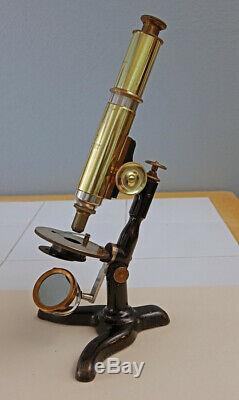
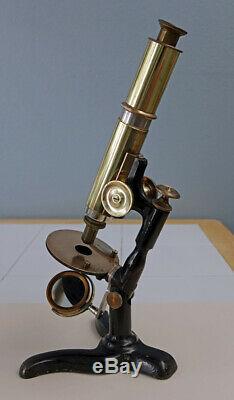
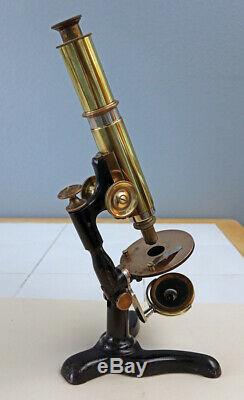

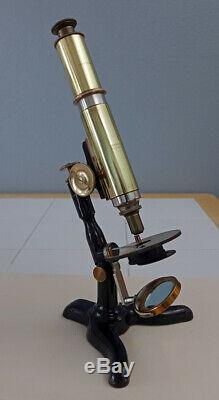
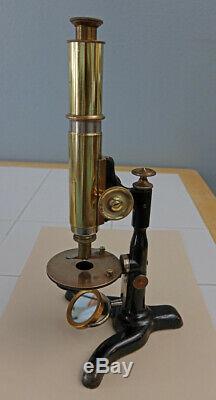

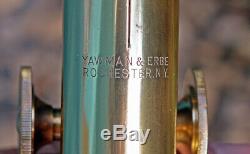


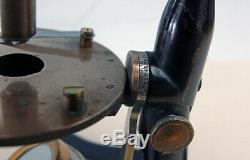
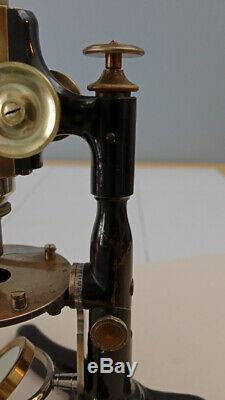

ANTIQUE BRASS NONPAREIL MICROSCOPE SIGNED ERNST GUNDLACH + YAWMAN & ERBE C1880. ANTIQUE BRASS NONPAREIL MICROSCOPE SIGNED BY ERNST GUNDLACH & YAWMAN & ERBE, ROCHESTER, NY CIRCA 1880. This is a double signed microscope. It is signed on the upper body tube ERNST GUNDLACH and, on the lower brass sleeve attached to the limb and that houses the body tube, it is also signed, YAWMAN & ERBE, ROCHESTER, NY. This microscope also features a unique in the limb fine focus mechanism that is described in detail below. Antique microscope collectors are very familiar with Ernst Gundlach. Gundlach, who was trained in the German optical tradition, is especially known for his significant influence on the design, evolution and development of the American microscope. This is due in part to his relatively brief but highly productive association with the Bausch & Lomb Optical Company (B&L) as that companys superintendent of their newly established microscope department. However, the instrument featured here was evidently made by Gundlach after he left the employ of B&L in 1878 and when he was briefly associated with Philip Yawman and Gustav Erbe (also former employees of B&L) in the production of microscopes. That association also lasted for a brief period of time the exact extent of which is unclear. NOTE: For more details on Ernst Gundlach and his association with Yauman & Erbe, please see below. As this microscope does not bear a typical serial number, it is not possible to determine an exact date of manufacture. However, given the fact that it bears dual signatures from the brief time when Gundlach and Yawman & Erbe were working closely together on the production of microscopes, we can conservatively date the instrument to circa 1880.
Accompanying this listing is an illustrated advertisement for this particular model microscope that appeared in the monthly journal The Microscope Volume III, Number XII in December of 1886. Please compare the advertised features to those of the listed instrument. The exact similarities to the listed instrument are readily apparent. Due in part to its dual signature status combined with the unique fine focus system found on this microscope along with the fact that it was designed by a famous American microscope optician, this antique brass microscope will make a very nice addition to any antique microscope collection, especially one that has a focus on American made microscopes.
This microscope features a nicely sculpted black Japanned Y-shaped tripod foot that supports a single cylindrical pillar that rises to a compass joint. This joint supports a cylindrical upper pillar and a round stage.The limb, in turn, supports the remainder of the microscope including the coarse focus mechanisms (of which there are two) and the body tube. The compass joint allows the microscope to be tilted at any angle from the vertical to horizontal to allow for the comfortable viewing of specimen slides mounted atop the stage. The body tube of this microscope is coarse focused via a horizontal brass rack and pinion system affixed to a brass sleeve that is attached to the upper limb.
A pair of brass milled heads is used to control the coarse focus. The body tube of the microscope is able to slide within this brass sleeve thereby providing a supplementary method of coarse focus. The fine focus mechanism on this microscope is entirely different from any that I have previously seen on other antique brass microscopes. One could write a book on the different types of fine focus systems found on antique brass microscopes. Some familiar examples include at the top of the limb, under the limb above the stage, on the front face or side of the body tube, behind the stage, under the limb below the stage, and even in the form of a tilting stage fine focus system.
The unique fine focus mechanism on this model microscope is found at the approximate midpoint of the upper limb. At this point the diameter of the limb gradually narrows down from 22mm to 15mm forming what looks like a pinched section of the limb.
Note: The pinched limb is a distinguishing physical characteristic of the Nonpareil model microscope that is easily identified from a distance. Fitting over this narrow section of the limb is a 22mm diameter upper limb extension that is internally spring loaded. This permits the upper limb extension, which connects to the brass sleeve that houses the body tube to move slightly up or down over the narrowed section of the limb. Fine focus is controlled by a brass milled head found at the top of the limb extension. Note: Please see the close-up image that shows this system. I checked this fine focus system out on a prepared glass slide and it works great. This mechanism is clearly an Ernst Gundlach invention. However, I could not find any record of it in the literature. Also, it appears that Gundlach never patented this device even though he patented several other significant improvements to the microscope while in the employ of Bausch & Lomb. The microscope is equipped with an 85mm diameter round stage with a 20mm diameter central aperture. There are provisions for a pair of slide clips. One is present, but the other one is missing from this instrument. Under the stage is a brass sleeve that accepts a rotating disc of apertures, which is present on this instrument. Also present under the stage is a yoke mounted double sided plano-concave mirror assembly (mounted in brass) found at the end of a flat nickel plated brass mirror bar. The mirror bar is able to pivot about the stage on a compass joint (the axis of which lies in the plane of the stage) such that it can be adjusted to any angle below the stage for oblique illumination and even above the stage to provide incidental illumination to opaque objects. (Note: Please see the accompanying composite image that shows the versatility of this arrangement). This is a simple modification of the Patented swinging substage mirror assembly first invented by the American Optician, Joseph Zentmayer in the year 1876.Note: Gundlach also claimed to have independently invented this system, but Zentmayer was the first to patent this feature. The upper section of the mirror bar at the compass joint behind the stage is inscribed with various angles so one can determine at which angle the mirror is set either above and below the stage (Note: Please see the accompanying close-up image that shows this feature). The body tube is made of two (2) interconnected parts. The lower portion of the body tube of this microscope consists of nickel-plated brass. The upper section of the body tube consists of lacquered brass and is designed to accept an eyepiece.
At the top of the body tube is a traditional top-hat style ocular (unmarked). At the distal end of the body tube is a dual part RMS objective presumably by Gundlach, but it is not marked. The lower optical element of this objective can be removed (unscrewed) to provide lower magnification views.Note: Period advertisements for this microscope indicate that the eyepiece is a one-inch and the provided objective is both a 2/3-inch and a one-inch (dual purpose). When this microscope is set up for observations, it stands about 13.5 inches tall.
The microscope itself weighs about 6 pounds. There is no wood case or any other accessories that come with this microscope. NOTE: The accompanying images, which were captured under ambient light conditions, are a part of this statement of condition.
Please take the time to view all of the images so you can confirm the condition of the microscope and so you will know exactly what you will be getting should you prove to be the proud new owner of this fine antique brass Nonpareil Microscope. In summary, this microscope is in good to very good condition cosmetically, optically and mechanically, but with a few relatively minor caveats as noted below. This microscope came to us in relatively poor cosmetic condition.
We decided to deviate from our customary practices relative to antique brass microscopes and performed a partial restoration of this instrument. Following disassembly, actions included the removal of age tarnish from the body tube, brass body tube sleeve and coarse focus knobs using a product called Pre-Lim. This was followed by a polishing of the brass with a microfiber cloth and a re-lacquering of the aforementioned brass parts. The remainder of the instrument was cleaned of dust and grime with Windex and then the entire instrument was given it a good coat of Renaissance Wax to preserve its luster. The Japanned black base and limb are in relatively good condition, but there are some spots on the base and limb where the black lacquer has worn off. The optics provided with this microscope (the eyepiece and objective lens) are in relatively good condition with no internal defects evident.Images of prepared slides that were viewed at the eyepiece were considered to be acceptable. Both sides of the plano-concave mirror are in relatively good condition, but with some minor spotting on the concave side. However, despite the minor surface defects it still provides very good illumination to the stage. Mechanically, the rack and pinion coarse focus mechanism works smoothly through most of its range.
However, the pinion gear has a couple of missing or bent teeth which prevents smooth movement throughout its full design range. However, the movement of the body tube within the brass sleeve makes up for this defect. As noted above, one of the slide clips is missing from the top of the stage. The rotating disc of apertures works smoothly.
The swinging substage mirror assembly rotates freely. All in all, this is a very well preserved example of Gundlachs Nonpareil Microscope. Given its now partially restored condition, it will certainly be a highly prized addition to any antique microscope collection, especially one that has an emphasis on the more rarely seen American made instruments. ABOUT ERNST GUNDLACH & YAWMAN & ERBE. The roots of the history of American microscope design and manufacture by Ernst Gundlach go back to 1872 when Ernst Gundlach, who was an established optician in Berlin, Germany immigrated to the USA.
At first he settled in Hackensack, New Jersey where he produced objective lenses of excellent quality. In 1876 Gundlach moved to Rochester, NY where he assumed the role of superintendent of the newly established microscope department of Bausch & Lomb Optical Company. However, due in part to his somewhat brash independent spirit and lack of business acumen, his career with the B&L firm would be short lived lasting less than 2 years in duration. Over the years, both while in the employ of Bausch & Lomb and while working independently, Ernst Gundlach was responsible for several significant US Patents for improvements in the design of the microscope and optical lenses for both microscopes and telescopes.
In 1878, due to work related differences, Gundlach was forced to leave Bausch & Lomb. For a brief period Gundlach worked with Philip Yawman and Gustav Erbe, who were also former employees of B&L, in the production of microscopes. While it is clear that it was Gundlach who produced the optics, it is less clear who produced the stands. It was during this time that the Nonpareil Microscope stand was offered for sale to the public.
Yawman & Erbe primarily were involved in the production of office furniture with microscope manufacture being only a secondary business. The Nonpareil Microscopes produced by this firm often bear the signature of either Ernst Gundlach or Yawman & Erbe and, in some cases, both signatures appear on the instruments.
How long this business arrangement lasted is unclear, but it appears to have been very short lived. Note: One advertisement from 1884 showed Yauman & Erbe offering the Nonpareil microscope model at the same time that the Gundlach Optical Company was offering it. In 1879, Gundlach and Lewis R. Sexton, set up an optical business in their home at 171 St.In 1880, Gundlach moved to Hartford, CT, leaving Sexton in charge of their optical business. While in Hartford, Gundlach listed himself as an independent Optician while still acting as an optical consultant to Sexton back in Rochester - another manifestation of his independent spirit. One microscope model that appeared during this time frame was one signed by Gundlach featuring a tilting stage fine focus and circular cast iron foot.
It included a wood case with an ink stamp that read, L. Sexton, Gundlach Microscopes & Objectives, No. 21 Stone Street, Rochester, NY. In August 1884 Lewis R. Reich, established the Gundlach Optical Company.
" In published advertisements, they claimed to be the "Sole Manufacturers of E. Gundlach's Microscopes and Objectives. During the next several years the company occupied several different locations in Rochester finally ending up at 761 South Clinton Avenue. In 1885, the Gundlach Optical Company initially offered just two microscope stands, a dissecting microscope and a monocular stand called the Nonpareil, a stand that Gundlach had also offered while associated with Yawman & Erbe years earlier. The Nonpareil stand very closely resembled the Physicians Microscope that Gundlach had designed for B&L, but which the new company now advertised under the general heading, Cheap Microscopes.
It appears that the company also experimented with a limited production of several other model microscopes. These other models tend to appear out of the woodwork from time to time. However, by the year 1893, the firm had dropped the Nonpareil and introduced a series of Continental stands. Beginning in 1890, the company gradually moved into the manufacture of lenses for cameras.As a result, the manufacture of microscopes assumed a less important role in their overall business model. Early in 1895, for reasons known only to Gundlach himself, he left the original Grundlach Optical Company and established a rival company called the "Gundlach Photo-Optical Company" at 5 South Water Street, Rochester. The emphasis of this company was on camera lenses. In the meantime, on August 6, 1902, the original Gundlach Optical Company acquired the Manhattan Optical Company of Cresskill, New Jersey, and changed the name of the company to the Gundlach-Manhattan Optical Company. All of the machinery, stock, patents and business of the Manhattan Optical Co were moved to Rochester, NY where the company manufactured several types of cameras and microscopes.
Ernst Gundlach died in Berlin, Germany in the year 1908. Back in the USA, The Gundlach-Manhattan Optical Company continued operations until around 1926 when the name of the company was changed again to Gundlach Manufacturing Company. After this the company went through several ownership and operational changes until it ceased operations in 1972. We will also entertain reasonable offers for this relatively uncommon Gundlach designed instrument.
FREE scheduling, supersized images and templates. Make your listings stand out with FREE Vendio custom templates!Over 100,000,000 served. Get FREE counters from Vendio today!
The item "ANTIQUE BRASS NONPAREIL MICROSCOPE SIGNED ERNST GUNDLACH + YAWMAN & ERBE C1880" is in sale since Wednesday, August 28, 2019. This item is in the category "Collectibles\Science & Medicine (1930-Now)\Scientific Instruments\Microscopes, Lab Equipment". The seller is "mtloggera" and is located in Hamilton, Montana. This item can be shipped worldwide.
- Country/Region of Manufacture: United States
- Antique Brass Microscope: Nonpareil Microscope
- Country of Manufacture: Rochester, NY USA
- Manufacturer: Ernst Gundlach + Yawman & Erbe
- Product Type: Microscopes, Lab Equipment

